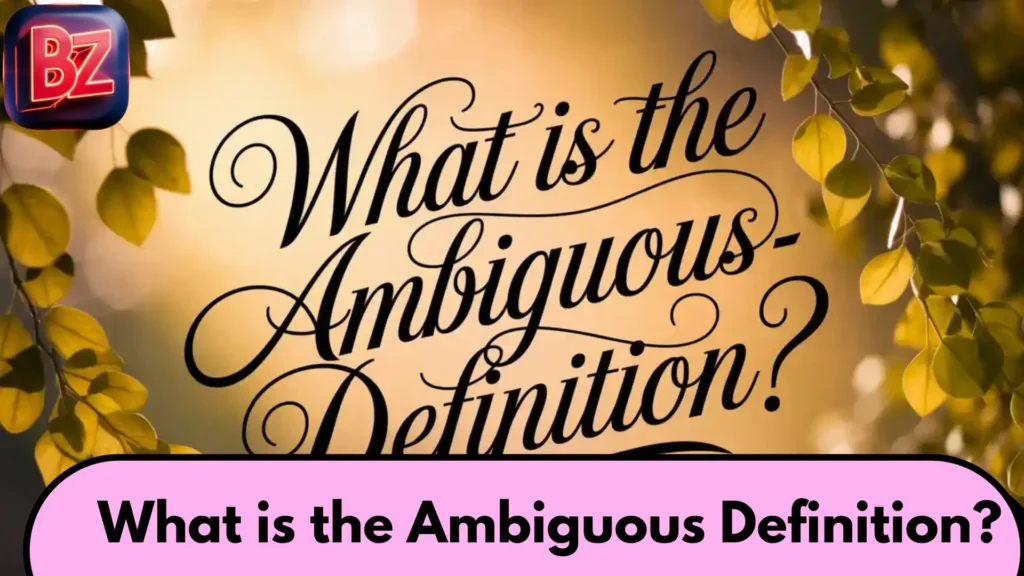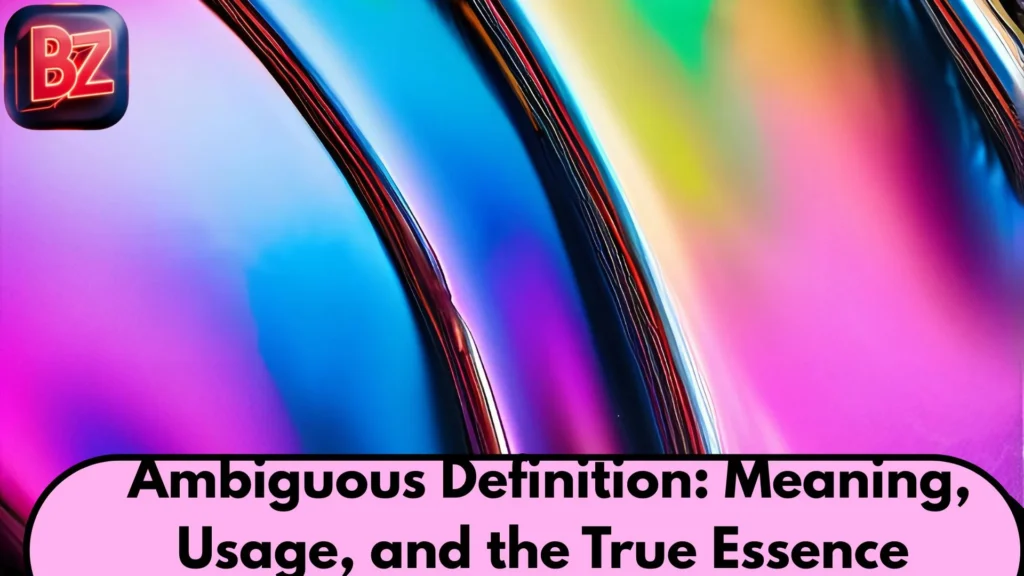In our daily conversations—whether online, at work, or in relationships—we often come across words or phrases that leave us wondering: “What did they mean?” That’s the power (and problem) of ambiguous language.
The term “ambiguous” refers to anything open to more than one interpretation, often leading to confusion, curiosity, or even conflict.
From casual texts to legal documents, ambiguity shows up everywhere. But while it can be creative and flexible, it can also damage trust or clarity if not used wisely. In this article, we’ll break down the ambiguous definition, explore its usage in different settings, and show you when to use it—and when to avoid it.
Whether you’re a writer, professional, student, or just curious, this guide will help you understand ambiguity like never before.
What is the Ambiguous Definition?

The word “ambiguous” refers to something that can be interpreted in more than one way. It comes from the Latin ambiguus, meaning “uncertain” or “open to more than one interpretation.” In today’s world, ambiguous language shows up everywhere—texts, emails, speeches, even in the fine print of contracts.
For example:
- “I’ll try to make it” could mean you’re attending, or that you might not.
- “We should talk” might be a friendly suggestion or a warning.
Ambiguity can be accidental or intentional. It can create confusion or give space for creativity. Knowing when and how to use (or avoid) ambiguous language is the real challenge.
What Does “Ambiguous” Stand For in Different Contexts?
In Literature
Ambiguity is a common literary device. Writers often use it to leave room for multiple interpretations, keeping the reader engaged.
Example: In Shakespeare’s Hamlet, the phrase “to be or not to be” leaves readers wondering about Hamlet’s true intentions.
In Law
Legal documents must aim to eliminate ambiguity, but it still sneaks in. Ambiguous clauses can lead to misunderstandings, loopholes, and even court cases.
Example: A phrase like “reasonable time” could be interpreted very differently by two parties.
In Relationships
Words like “I need space” or “Let’s see where this goes” are classic examples. They lack commitment and leave interpretation up to the listener.
In Business
Unclear goals or vague feedback can affect employee performance. Ambiguous instructions create confusion and delays.
Example: Saying “improve your output” without specifics leaves room for uncertainty.
Hiatus and Its Connection to Ambiguous Definition
A hiatus refers to a break or pause—but it doesn’t clarify duration or intent. That’s where ambiguity creeps in.
Common Examples of Ambiguous Hiatuses
- A celebrity announces a “hiatus” from social media. Are they quitting, or just taking a short break?
- A company pauses a product line. Will it return or disappear forever?
Hiatuses become ambiguous when the outcome is not defined, causing speculation and confusion among the audience.
Ambiguous Meaning in Text: Why Tone Matters
Text-based communication is ripe with ambiguity. Without vocal tone or body language, meanings often get lost.
Consider This:
“Sure, that’s fine.”
This could mean:
- Genuine agreement
- Passive-aggressive frustration
- Indifference
The tone is missing, which opens the door for misinterpretation.
Avoiding Ambiguity in Text:
- Use clear punctuation
- Add contextual cues
- Don’t rely solely on emojis
If unsure, follow up with clarifying statements like, “Just to be clear, I meant that…”
Choosing Alternatives: How to Replace Ambiguous Language
Being vague might seem polite, but it often leads to confusion. Let’s break down clearer alternatives for various tones.
Casual Tone
Instead of: “Let’s see how it goes.”
Say: “Let’s check in next Friday to make a decision.”
Professional Tone
Instead of: “We might consider this.”
Say: “We will review this option during the Q3 meeting.”
Polite but Firm
Instead of: “Maybe some other time.”
Say: “Thank you, but I won’t be available for this.”
Replacing vague phrases with specific and intentional wording builds trust and saves time.
11 Best Real-Life Examples of Ambiguity in Language
1. “I saw her duck.”
Did she crouch, or is she holding a duck?
2. “The chicken is ready to eat.”
Is it cooked, or is it hungry?
3. “He’s hot.”
Temperature or attractiveness?
4. “Flying planes can be dangerous.”
Flying them or just being near them?
5. “I’ll give you a ring.”
Phone call or jewelry?
6. “They are cooking apples.”
Are the apples being cooked, or are they people who cook apples?
7. “The old man the boats.”
Grammatically correct, but hard to interpret without context.
8. “I can’t recommend this enough.”
Is it a strong endorsement or subtle criticism?
9. “He promised to give me a ring tomorrow.”
Is it a proposal or just a call?
10. “Visiting relatives can be annoying.”
Are you visiting, or are they?
11. “The bass was hard to catch.”
Is it a fish or a musical note?
Why Ambiguous Language Persists
Despite its flaws, ambiguity often serves a purpose.
Reasons It Stays Around:
- Flexibility: Lets you adapt or delay decisions.
- Softens Rejection: Sounds gentler than being blunt.
- Artistic Effect: Invites the audience to explore meanings.
- Diplomatic Language: Keeps talks open without commitment.
We use ambiguous language not just by accident, but often by choice.
When is Ambiguity Useful?
There are situations where ambiguity is strategic:
Diplomatic Conversations
Politicians often speak in ways that allow different groups to hear what they want to hear.
Creative Writing
Authors use ambiguity to provoke thought and discussion.
Marketing Campaigns
Taglines like “Think Different” (Apple) are intentionally vague but emotionally powerful.
Leadership Communication
When facts are still forming, leaders may use ambiguity to buy time without making promises.
Ambiguity, when used purposefully, can inspire, protect, or engage.
How to Avoid Being Ambiguous
Clear communication creates stronger relationships and fewer misunderstandings.
Tips to Stay Clear:
Be Specific
- Unclear: “Let’s do it soon.”
- Clear: “Let’s meet this Friday at 2 PM.”
Use Active Voice
- Unclear: “The report was sent.”
- Clear: “I emailed the report to you at noon.”
Eliminate Vague Qualifiers
Words like “maybe,” “sort of,” and “possibly” introduce uncertainty.
Ask for Feedback
Confirm understanding by saying:
“Did that make sense?” or “Would you like me to explain further?”
Use Examples
Don’t just describe—demonstrate.
Instead of: “This tool is intuitive.”
Say: “You can drag and drop files without needing to navigate complex menus.”
Conclusion: Clarify or Confuse — The Choice is Yours
Ambiguity isn’t inherently bad—but it requires intention. When used with purpose, it can invite creativity, soften conflict, or keep discussions fluid. But in most daily interactions—emails, texts, meetings—clarity is far more valuable.
In a world buzzing with information, the clearest voices cut through the noise. So next time you’re tempted to say, “we’ll see,” consider offering a direct answer instead. Your words could be the difference between confusion and confidence.

Muhammad Haroon is a passionate writer and a visionary creator. With a deep commitment to sharing wisdom and positivity, he has dedicated his work to inspiring others through his thoughtful words and meaningful content. As the founder of Blessings Zings, Muhammad combines his expertise in writing with his love for spreading joy and gratitude.

